The Influence of TBC Aging on Crack Propagation Due to Foreign Object Impact
Abstract
:1. Introduction
2. Experimental Research
3. Numerical Studies
4. Conclusions
Author Contributions
Funding
Conflicts of Interest
References
- Sadowski, T.; Golewski, P. Multidisciplinary analysis of the operational temperature increase of turbine blades in combustion engines by application of the ceramic thermal barrier coatings (TBC). Comp. Mat. Sci. 2011, 50, 1326–1335. [Google Scholar] [CrossRef]
- Sadowski, T.; Golewski, P. The influence of quantity and distribution of cooling channels of turbine elements on level of stresses in the protective layer TBC and the efficiency of cooling. Comp. Mat. Sci. 2012, 52, 293–297. [Google Scholar] [CrossRef]
- Sadowski, T.; Golewski, P. The analysis of heat transfer and thermal stresses in thermal barrier coatings under exploitation. Def. Diff. For. 2012, 326–328, 530–535. [Google Scholar] [CrossRef]
- Sadowski, T.; Golewski, P. Detection and numerical analysis of the most efforted places in turbine blades under real working conditions. Comp. Mat. Sci. 2012, 64, 285–288. [Google Scholar] [CrossRef]
- Sadowski, T.; Golewski, P. Experimental and numerical investigations of TBC behavior after aging, subjected to tension and bending. Sol. Sta. Phen. 2014, 216, 128–133. [Google Scholar] [CrossRef]
- Sadowski, T.; Golewski, P. Cracks path growth in turbine blades with TBC under thermo—mechanical cyclic loadings. Frat. ed Integrità Strutt. 2016, 35, 492–499. [Google Scholar] [CrossRef]
- Sadowski, T.; Golewski, P. The use of experimental bending tests to more accurate numerical description of TBC damage process. Mat. Sci. Eng. 2016, 123. [Google Scholar] [CrossRef]
- Sadowski, T.; Golewski, P. Numerical and experimental analysis of foreign objects impact into the surface with TBC coating. Sol. St. Phen. 2016, 254, 224–230. [Google Scholar] [CrossRef]
- Saucedo-Mora, L.; Slámečka, K.; Thandavamoorthy, U.; Marrowa, T.J. Multi-scale modeling of damage development in a thermal barrier coating. Surf. Coat. Techn. 2015, 276, 399–407. [Google Scholar] [CrossRef]
- Nayebpashaee, N.; Seyedein, S.H.; Aboutalebi, M.R.; Sarpoolaky, H.; Hadavi, S.M.M. Finite element simulation of residual stress and failure mechanism in plasma sprayed thermal barrier coatings using actual microstructure as the representative volume. Surf. Coat. Techn. 2016, 291, 103–114. [Google Scholar] [CrossRef]
- Ranjbar-Far, M.; Absi, J.; Shahidi, S.; Marivaux, G. Impact of the non-homogenous temperature distribution and the coatings process modeling on the thermal barrier coatings system. Mat. Des. 2011, 32, 728–735. [Google Scholar] [CrossRef]
- Wanga, L.; Zhong, X.H.; Yang, J.S.; Tao, S.Y.; Zhang, W.; Wangd, Y.; Sun, X.G. Finite element simulation of surface micro-indentation behavior of yttria stabilized zirconia thermal barrier coatings with microstructural characteristic of columnar grains and sub-grains based on a nonlinear contact model. Comp. Mat. Sci. 2014, 82, 244–256. [Google Scholar] [CrossRef]
- Wang, L.; Li, D.C.; Yang, J.S.; Shao, F.; Zhong, X.H.; Zhao, H.Y.; Yang, K.; Tao, S.; Wang, Y. Modeling of thermal properties and failure of thermal barrier coatings with the use of finite element methods: A review. J. Eur. Cer. Soc. 2016, 36, 1313–1331. [Google Scholar] [CrossRef]
- Dong, H.; Han, Y.; Zhou, Y.; Li, X.; Yao, J.T.; Li, Y. The temperature distribution in plasma-sprayed thermal-barrier coatings during crack propagation and coalescence. Coatings 2018, 8, 311. [Google Scholar] [CrossRef]
- Lin, C.; Chai, Y.J.; Li, Y.M. Oxidation simulation of thermal barrier coatings with actual microstructures considering strength difference property and creep-plastic behavior. Coatings 2018, 8, 338. [Google Scholar] [CrossRef]
- Prapamonthon, P.; Yooyen, S.; Sleesongsom, S.; Dipasquale, D.; Xu, H.; Wang, J.; Ke, Z. Investigation of cooling performances of a non-film-cooled turbine vane coated with a thermal barrier coating using conjugate heat transfer. Energies 2018, 11, 1000. [Google Scholar] [CrossRef]
- Chai, Y.J.; Lin, C.; Wang, X.; Li, Y.M. Study on stress development in the phase transition layer of thermal barrier coatings. Materials 2016, 9, 773. [Google Scholar] [CrossRef]
- Cernuschia, F.; Lorenzonia, L.; Capelli, S.; Guardamagnaa, C.; Kargerb, M.; Vaßenb, R.; Von Niessen, K.; Markocsand, N.; Menueye, J.; Giolli, C. Solid particle erosion of thermal spray and physical vapour deposition thermal barrier coatings. Wear 2011, 271, 2909–2918. [Google Scholar] [CrossRef]
- Chen, X.; He, M.Y.; Spitsberg, L.; Fleck, N.A.; Hutchinson, J.W.; Evans, A.G. Mechanisms governing the high temperature erosion of thermal barrier coatings. Wear 2004, 256, 735–746. [Google Scholar] [CrossRef]
- Chen, X.; Hutchinson, J.W. Particle impact on metal substrates with application to foreign object damage to aircraft engines. J. Mech. Phy. Sol. 2002, 50, 2669–2690. [Google Scholar] [CrossRef]
- Crowell, M.W.; Schaedler, T.A.; Hazel, B.H.; Konitzer, D.G.; McMeeking, R.M.; Evans, A.G. Experiments and numerical simulations of single particle foreign object damage-like impacts of thermal barrier coatings. Int. J. Imp. Eng. 2012, 48, 116–124. [Google Scholar] [CrossRef]
- Wellman, R.G.; Deakin, M.J.; Nicholls, J.R. The effect of TBC morphology and aging on the erosion rate of EB-PVD TBCs. Trib. Int. 2005, 38, 798–804. [Google Scholar] [CrossRef]
- Wellman, R.G.; Nicholas, J.R. Erosion, corrosion and erosion–corrosion of EB PVD thermal barrier coatings. Trib. Int. 2008, 41, 657–662. [Google Scholar] [CrossRef] [Green Version]
- MasoudMarandi, S.; Rahmani, K.; Tajdari, M. Foreign object damage on the leading edge of gas turbine blades. Aero. Sci. Tech. 2014, 33, 65–75. [Google Scholar] [CrossRef]
- Carter, T.J. Common failures in gas turbine blades. Eng. Fail. Anal. 2005, 12, 237–247. [Google Scholar] [CrossRef]
- Kumar, V.; Balasubramanian, K. Progress update on failure mechanisms of advanced thermal barrier coatings: A review. Prog. Org. Coat. 2016, 90, 54–82. [Google Scholar] [CrossRef]
- Tsai, P.C.; Lee, J.H.; Chang, C.L. Improving the erosion resistance of plasma-sprayed zirconia thermal barrier coatings by laser glazing. Surf. Coat. Techn. 2007, 202, 719–724. [Google Scholar] [CrossRef]
- Zhang, X.F.; Zhou, K.S.; Dong, S.J.; Xu, W.; Song, J.B.; Liu, M. Effect of Al-deposition on erosion resistance of plasma sprayed thermal barrier coating. Trans. Nonferrous Met. Soc. China 2015, 25, 2587–2593. [Google Scholar] [CrossRef]
- Tzimas, E.; Mullejans, H.; Peteves, S.D.; Bresser, J.; Stamm, W. Failure of thermal barrier coating systems under cyclic thermomechanical loading. Acta Mater. 2000, 48, 4699–4707. [Google Scholar] [CrossRef]
- Sadowski, T.; Kneć, M.; Golewski, P. Experimental investigation and numerical modelling of spot welding-adhesive joints response. Comp. Struct. 2014, 112, 66–77. [Google Scholar] [CrossRef]
- Debski, H.; Sadowski, T. Modelling of microcracks initiation and evolution along interfaces of the WC/Co composite by the finite element method. Comp. Mat. Sci. 2014, 83, 403–411. [Google Scholar] [CrossRef]
- Golewski, G.; Sadowski, T. An analysis of shear fracture toughness KIIc and mictrostructure in concrete containing fly-ash. Constr. Build. Mater. 2014, 51, 207–214. [Google Scholar] [CrossRef]
- Gajewski, J.; Sadowski, T. Sensitivity analysis of crack propagation in pavement bituminous layered structures using a hybrid system integrating artificial neural networks and finite element method. Comp. Mat. Sci. 2014, 82, 114–117. [Google Scholar] [CrossRef]
- Sadowski, T. Gradual degradation in two-phase ceramic composites under compression. Comp. Mat. Sci. 2012, 64, 209–211. [Google Scholar] [CrossRef]
- Marsavina, L.; Linul, E.; Constantinescu, D.; Apostol, D.; Voiconi, T.; Sadowski, T. Refinements on fracture toughness of PUR foams. Eng. Fract. Mech. 2014, 129, 54–66. [Google Scholar] [CrossRef]
- Birsan, M.; Sadowski, T.; Marsavina, L.; Linul, E.; Pietras, D. Mechanical behavior of sandwich composite beams made of foam and functionally graded materials. Int. J. Solids Struct. 2013, 50, 519–530. [Google Scholar] [CrossRef]
- Sadowski, T.; Marsavina, L. Multiscale modelling of two-phase ceramic matrix composites. Comp. Mat. Sci. 2011, 50, 1336–1346. [Google Scholar] [CrossRef]
- Sadowski, T.; Naubrand, A. Estimation of the Crack Length After Thermal Shock in FGM Strip. Int. J. Fract. 2004, 127, L135–L140. [Google Scholar] [CrossRef]
- Sadowski, T.; Ataya, S.; Nakonieczny, K. Thermal analysis of layered FGM cylindrical plates subjected to sudden cooling process at one side—Comparison of two applied methods for problem solution. Comp. Mat. Sci. 2009, 45, 624–632. [Google Scholar] [CrossRef]
- Sadowski, T.; Nakonieczny, K. Thermal shock response of FGM cylindrical plates with various grading patterns. Comput. Mat. Sci. 2008, 43, 171–178. [Google Scholar] [CrossRef]
- Marsavina, L.; Sadowski, T. Stress intensity factors for an interface kinked crack in a bi-material plate loaded normal to the interface. Int. J. Frac. 2007, 145, 237–243. [Google Scholar] [CrossRef]
- Burlayenko, V.; Altenbach, H.; Sadowski, T.; Dimitrova, S.D. Computational simulations of thermal shock cracking by the virtual crack closure technique in a functionally graded plate. Comp. Mat. Sci. 2016, 116, 11–21. [Google Scholar] [CrossRef]
- Sadowski, T.; Bęc, J. Effective properties for sandwich plates with aluminium foil honeycomb core and polymer foam filling - static and dynamic response. Comp. Mat. Sci. 2011, 50, 1269–1275. [Google Scholar] [CrossRef]

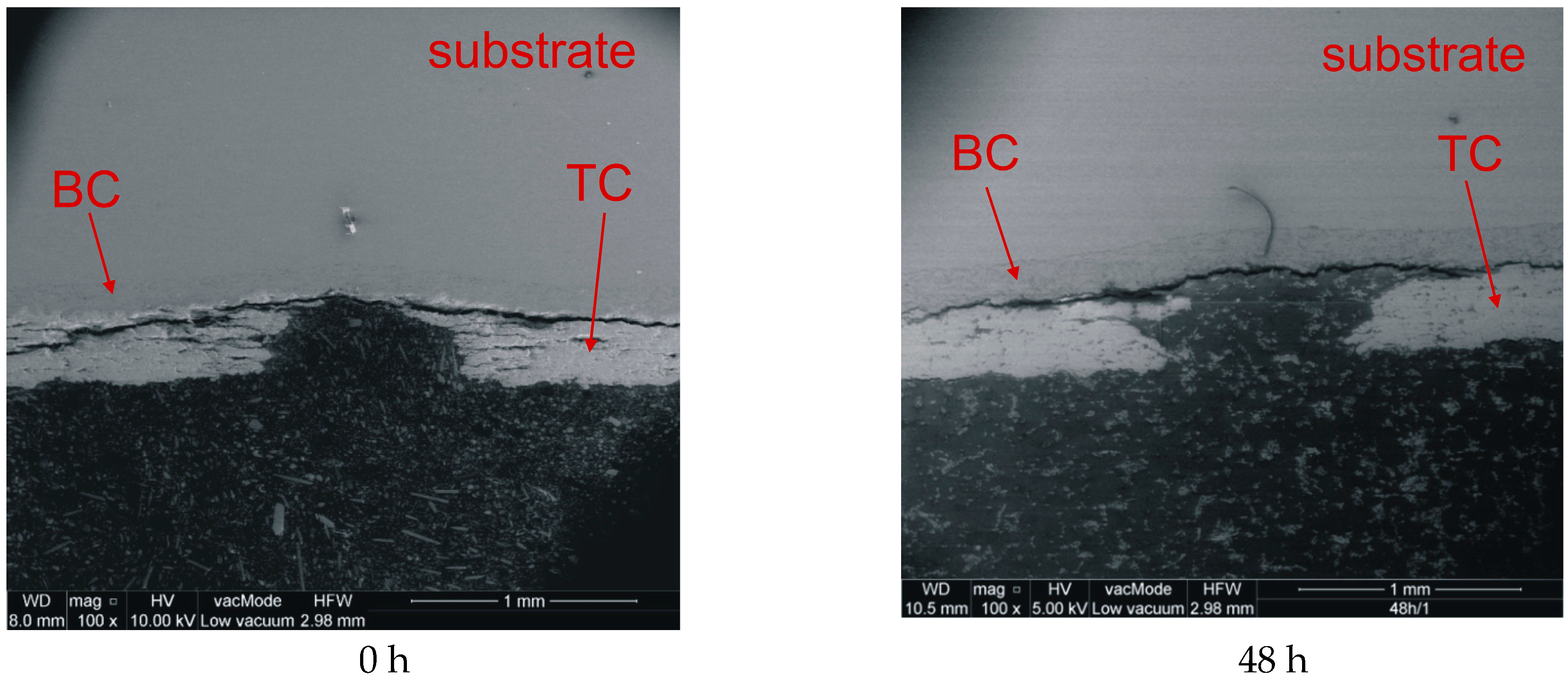
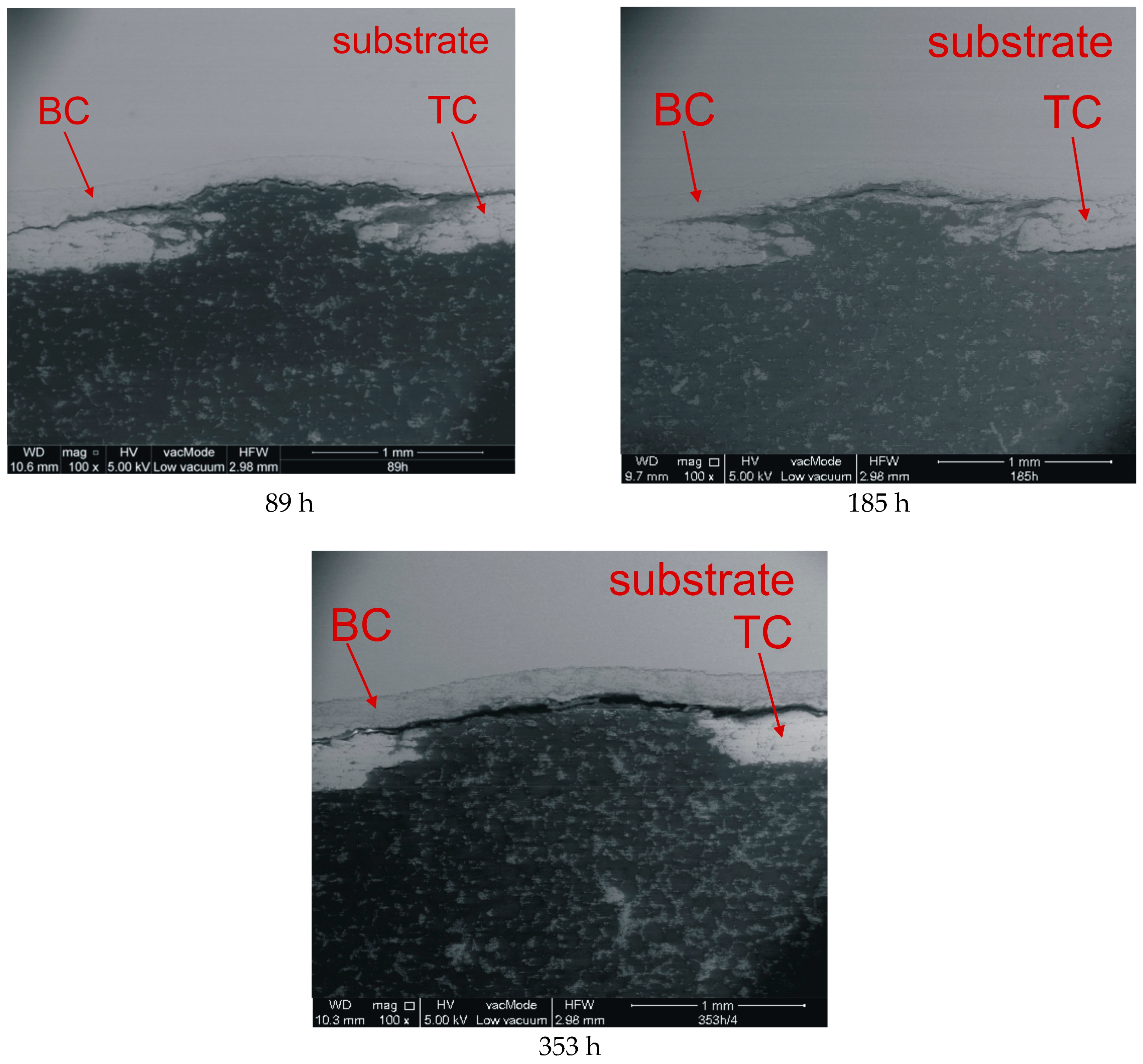

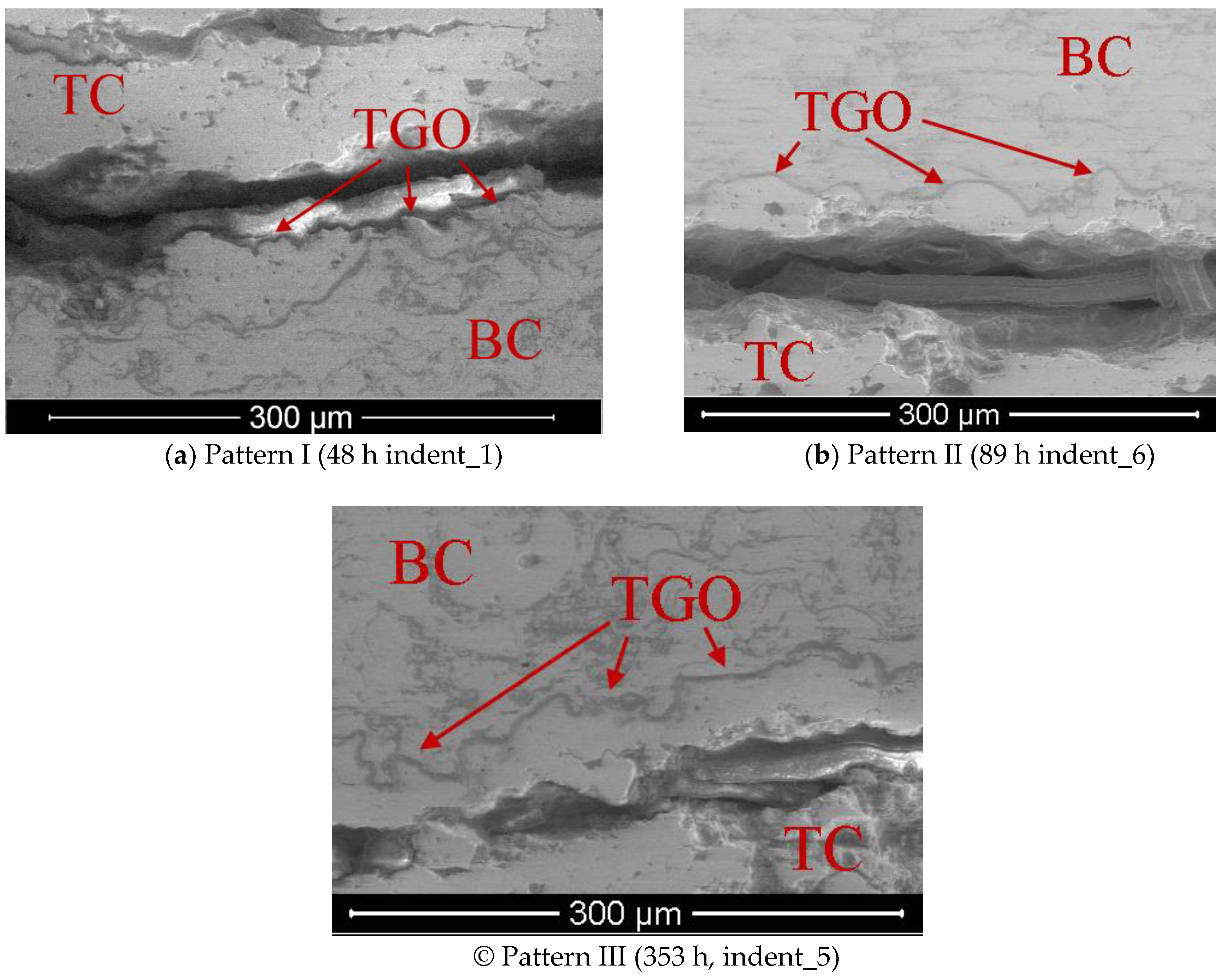
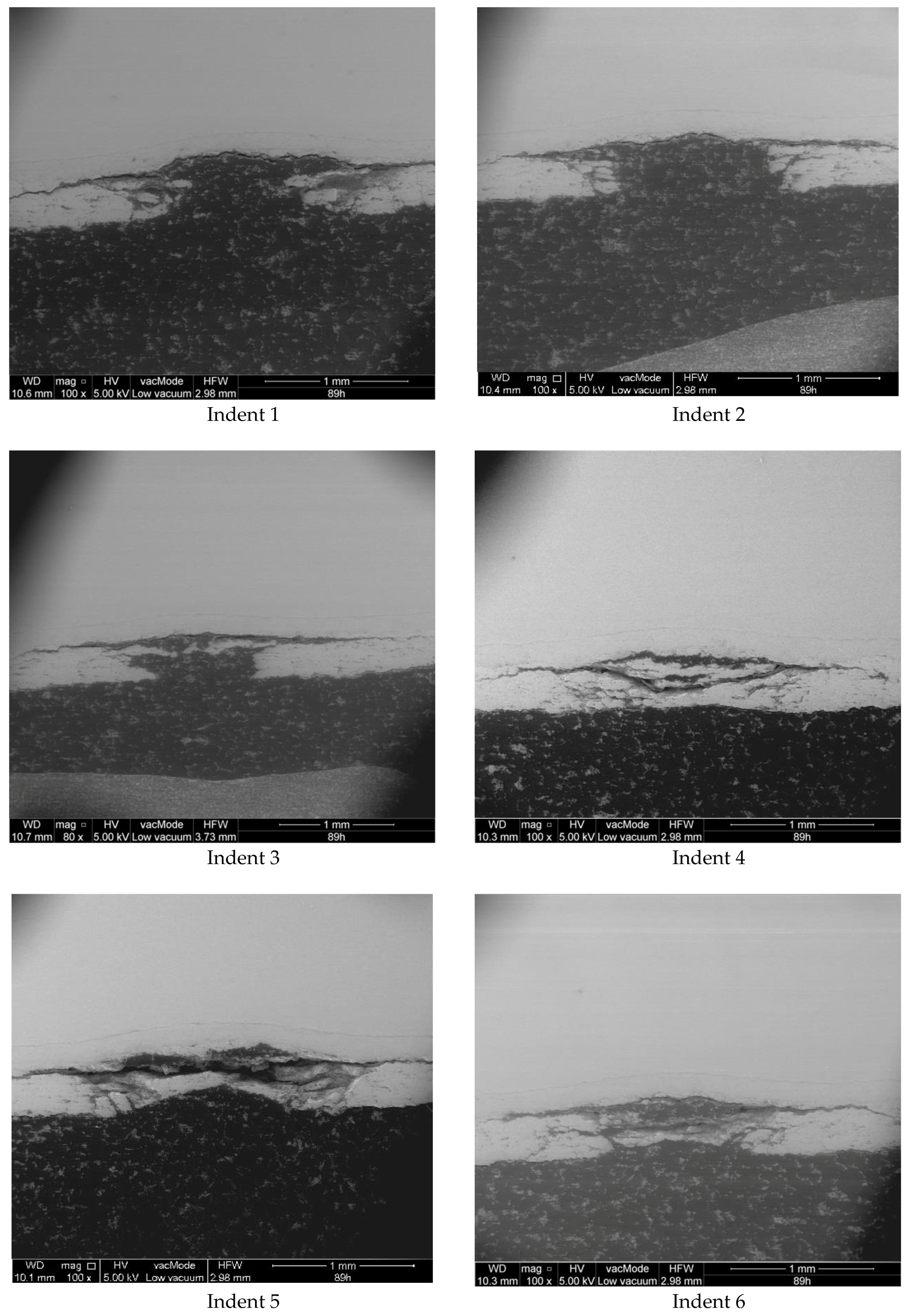
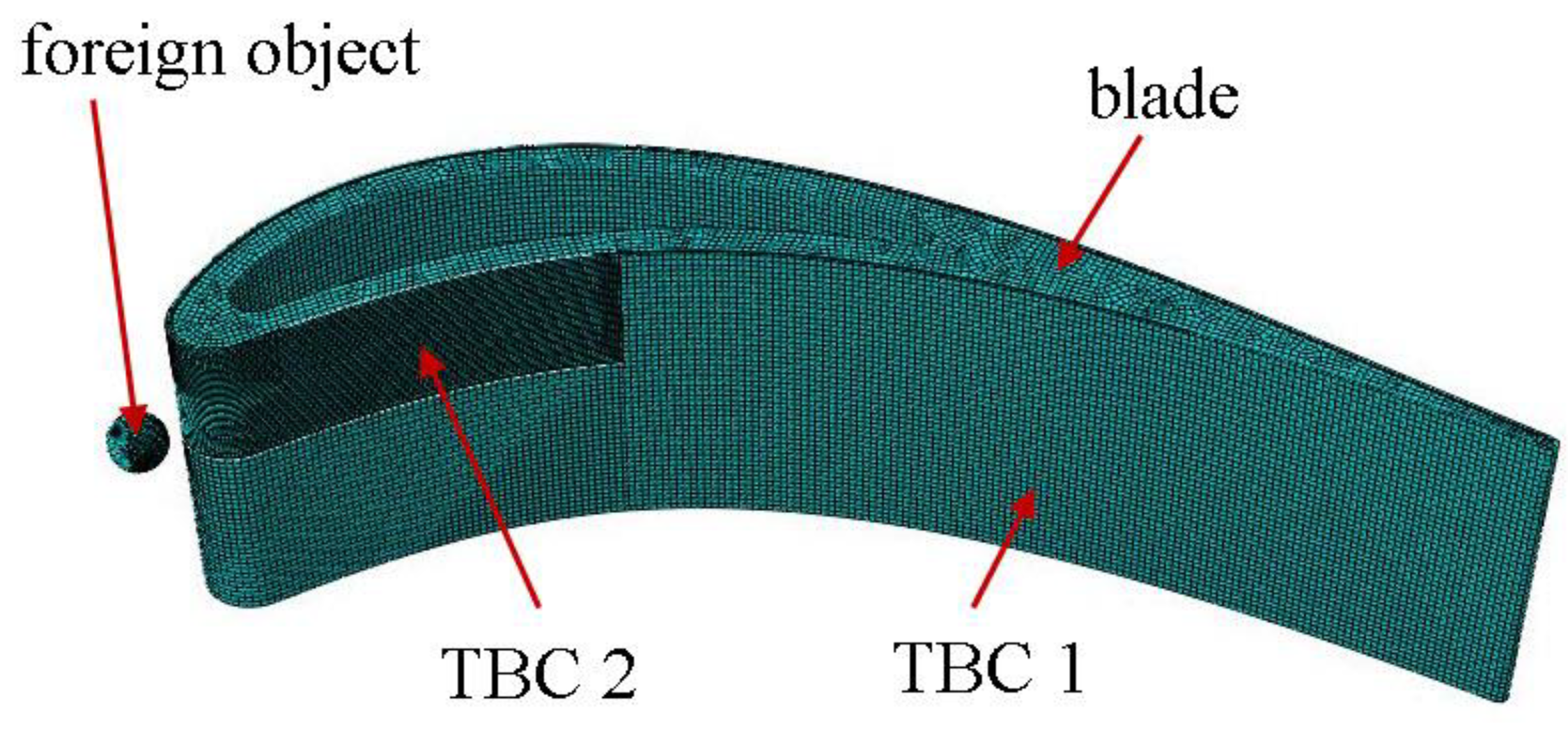


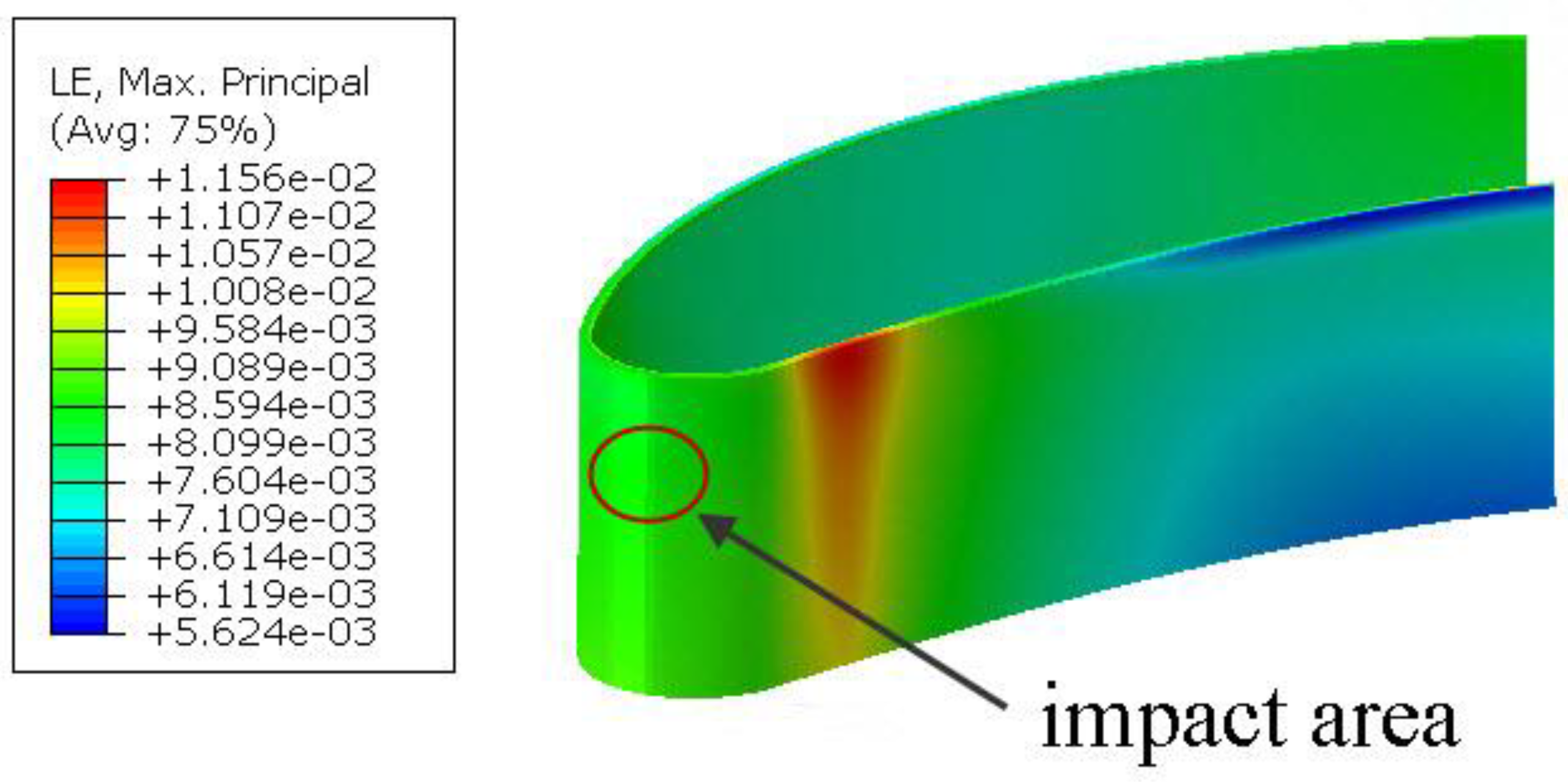
| No. of Impacted Point | 0 h | 48 h | 89 h | 185 h | 353 h |
|---|---|---|---|---|---|
| 1 | 74.84 | 74.84 | 74.84 | 74.84 | 74.73 |
| 2 | 74.07 | 73.91 | 74.22 | 74.22 | 74.07 |
| 3 | 73.39 | 72.81 | 73.39 | 73.39 | 73.20 |
| 4 | 72.18 | 71.74 | 71.96 | 72.40 | 71.96 |
| 5 | 71.04 | 70.31 | 70.80 | 71.04 | 70.56 |
| 6 | 69.81 | 69.05 | 69.56 | 70.06 | 69.56 |
| Type of Finite Element | Foreign Object | TBC 1 | TBC 2 | Blade |
|---|---|---|---|---|
| C3D8R | 12,160 | 35,240 | 57,800 | 92,050 |
| C3D6 | 1408 | - | - | 1650 |
| Material Property | Temp. | Substrate | Bond-Coat (BC) | Top-Coat (YSZ) |
|---|---|---|---|---|
| Young modulus (GPa) | 25 °C | 200 | 200 | 85 |
| 1000 °C | 150 | 120 | 35 | |
| Poisson’s ratio | 25 °C | 0.33 | 0.3 | 0.1 |
| 1000 °C | 0.33 | 0.3 | 0.1 | |
| Thermal exp. coeff. (10−6 1/K) | 100 °C | 10.8 | 10 | 9.2 |
| 1000 °C | 16.8 | 17.5 | 10.5 | |
| Density (kg/m3) | 25 °C | 8500 | 7380 | 3610 |
| 1000 °C | 8500 | 7030 | 3510 | |
| Specific heat (J/kgK) | 25 °C | 440 | 450 | 505 |
| 1000 °C | 700 | 980 | 630 | |
| Thermal conductivity (W/mK) | 25 °C | 8.9 | 10.8 | 0.9 |
| 1000 °C | 21.6 | 32.1 | 0.3 |
| α | 82.39° | 70.48° | 58.57° | 46.76° | 34.84° |
|---|---|---|---|---|---|
| Cold blade | 6 | 8 | 18 | 8 | 2 |
| Hot blade | 6 | 8 | 13 | 10 | 4 |
© 2019 by the authors. Licensee MDPI, Basel, Switzerland. This article is an open access article distributed under the terms and conditions of the Creative Commons Attribution (CC BY) license (http://creativecommons.org/licenses/by/4.0/).
Share and Cite
Golewski, P.; Sadowski, T. The Influence of TBC Aging on Crack Propagation Due to Foreign Object Impact. Materials 2019, 12, 1488. https://doi.org/10.3390/ma12091488
Golewski P, Sadowski T. The Influence of TBC Aging on Crack Propagation Due to Foreign Object Impact. Materials. 2019; 12(9):1488. https://doi.org/10.3390/ma12091488
Chicago/Turabian StyleGolewski, Przemysław, and Tomasz Sadowski. 2019. "The Influence of TBC Aging on Crack Propagation Due to Foreign Object Impact" Materials 12, no. 9: 1488. https://doi.org/10.3390/ma12091488





